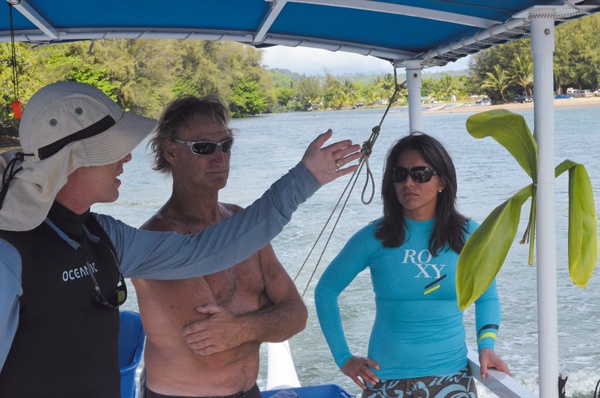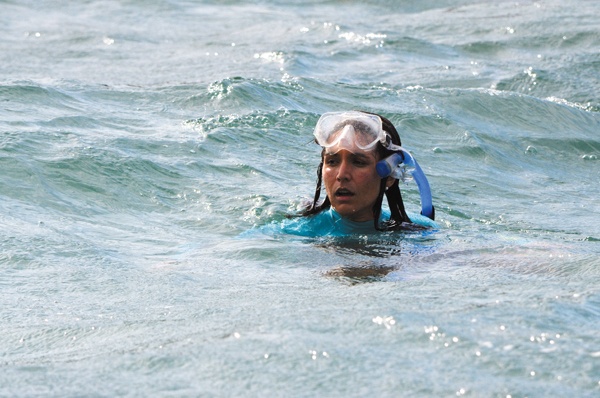HANALEI — As part of a busy Aloha Friday schedule on Kauai, U.S. Rep. Tulsi Gabbard went in the water to see Kauai’s diseased coral reefs for herself. “It was troubling to see what once was beautiful, vibrant coral reef
HANALEI — As part of a busy Aloha Friday schedule on Kauai, U.S. Rep. Tulsi Gabbard went in the water to see Kauai’s diseased coral reefs for herself.
“It was troubling to see what once was beautiful, vibrant coral reef decaying and withering away,” the Congresswoman said.
After initially being contacted by Hanalei resident Mike Sheehan, Gabbard accepted an invitation to tour the area and learn about the disease outbreak.
“It was important for me to be there,” she said, “to be able to gain a better understanding.”
It was a move that went over well with the scientists and biologists involved in the ongoing study.
“We were so pleased to have a member of the congressional delegation come out,” said Dr. Greta Aeby, a coral expert with the Hawaii Institute of Marine Biology at the University of Hawaii. “To see people that are in a position to help protect our natural resources is very important.”
Gabbard’s guides for the day included Aeby, Hanalei biologist Terry Lilley and Dr. Thierry Work, a wildlife disease specialist for the U.S. Geological Survey’s National Wildlife Health Center in Honolulu.
The boat trip — captained by Sheehan — began with a short jaunt up the Hanalei River to look at the digging in the wetland, which Lilley says is causing a large amount of mud and sediment to be dumped out onto the reef.
From there, Gabbard, her chief of staff Amy Asselbaye and Kauai field representative Kaulana Finn were taken across the bay to look at diseased coral colonies on Waipa Reef.
Gabbard did little talking, but her eyes and ears were wide open.
“We explained to (Gabbard) how the land-use patterns are affecting the coral reefs,” Work said after the tour.
Gabbard said it was obvious the reef at Waipa is in bad shape.
“It’s apparent to anyone to see the lack of fish in the area, to see the actual decay and the browning and withering away of the beautiful coral,” she said.
Gabbard described her experience Friday as “eye-opening” and said there is no question action must be taken.”
“I’m going to do whatever I can to help,” she said, adding that she and her staff will continue doing their own research and working with the experts in the field.
Aeby, who led Gabbard’s underwater tour, described Friday’s visit as a “rare event.”
“Not only did Tulsi show the interest, make time to come out here and listen to the problem, but she actually got in the water and was looking at this problem first-hand,” she said. “This is critically important and we’re hoping from actions such as this that indeed people will start to take notice.”
Lilley, who first alerted scientists to the outbreak more than a year ago, said he was excited to finally start getting “the right people” in the water.
“We’ve got 100,000 dead corals out there, dying right now,” he said. “And there’s more people tonight caring about them than there were yesterday.”
The epidemic — which Work and Aeby have now confirmed at several North Shore locations — is caused by a variety of bacteria working together to rapidly eat away coral tissues.
Gabbard described Hanalei as “a beautiful piece of Hawaii.”
“To go below the surface to see this destruction happening before our very eyes is very, very troubling and concerns me deeply.”
Gabbard said it is time to start looking at the bigger picture and the affect people are having on the ocean ecosystem in Hawaii.
“Awareness is usually the biggest way to be able to create the pressure to affect change and cause action,” she said.
Gabbard’s day-long visit to Kauai also included speaking at the Kauai Drug Court graduation ceremony and attending Kauai Community College’s screening of “The Invisible War,” an investigative documentary about rape in the military.
Following the screening, the Congresswoman participated in a panel discussion about the issue.
Gabbard is a captain in the Hawaii Army National Guard and one of the first female combat veterans to serve in Congress. Earlier this month, she introduced the Military Justice Improvement Act — HR 2016 — which would reform the military justice system by taking away command influence in the prosecution of crimes with a punishment of one year or more in confinement.
• Chris D’Angelo, environmental writer, can be reached at 245-0441 or cdangelo@thegardenisland.com.



